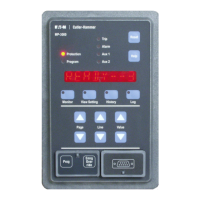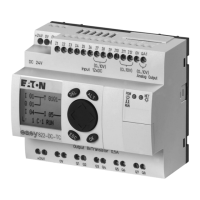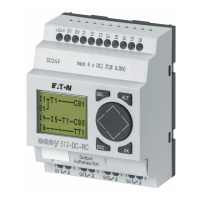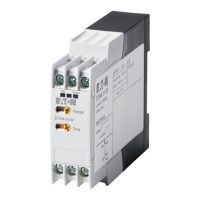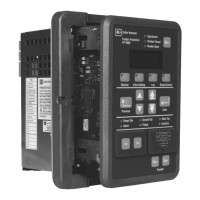Page 5-4
www.eaton.com
IB02602002E MP-4000
5.2.1 Setting P2L1, RTD Display Information (RTD IN C or
RTD IN F)
P2L1 species the temperature displays in degrees Celsius or degrees
Fahrenheit.
5.2.2 Setting P2L2, Winding Temp Trip (WD T)
WD T species the motor stator winding temperature limit above which
the hottest winding RTD causes the relay to trip the motor. This trip
can also be set to OFF. Trip temperature values are in degrees C or F,
depending on Setting P2L1. There are six specically-labeled stator
RTD inputs on the URTD module whose readings can trigger this par-
ticular type of trip. See Subsection 9.1.8 for setting advice.
CAUTION
IF WD T IS SET TO OFF, THE THERMAL-MODEL PROTECTION
REVERTS TO THE NON-RTD ALGORITHM EVEN IF A URTD IS
CONNECTED.
5.2.3 Setting P2L3, Winding Temp Alarm (WD A)
Species the motor stator winding temperature limit above which any
winding RTD produces an alarm output from the relay. This alarm can
also be set to OFF. Alarm temperature values are in degrees C or F,
depending on Setting P2L1. There are six specically-labeled stator
RTD inputs on the URTD module whose readings can trigger this
particular type of alarm.
5.2.4 Setting P2L4, Motor Bearing Trip (MB T)
P2L4 species the motor bearing temperature limit above which either
of the two motor bearing RTDs causes the relay to trip the motor. This
trip can also be set to OFF. Trip temperature values are in degrees C
or F, depending on Setting P2L1. There are two specically-labeled
motor bearing RTD inputs on the URTD module whose readings can
trigger this particular type of trip.
5.2.5 Setting P2L5, Motor Bearing Alarm (MB A)
P2L5 species the motor bearing temperature limit above which either
of the two motor bearing RTDs produces an alarm output from the
relay. This alarm can also be set to OFF. Alarm temperature values
are in degrees C or F, depending on Setting P2L1. There are two spe-
cically-labeled motor bearing RTD inputs on the URTD module whose
readings can trigger this particular type of alarm.
5.2.6 Setting P2L6, Load Bearing Trip (LB T)
P2L6 species the load bearing temperature limit above which either of
the two load bearing RTDs causes the relay to trip the motor. This trip
can also be set to OFF. Trip temperature values are in degrees C or
F, depending on Setting P2L1. There are two specically-labeled load
bearing RTD inputs on the URTD module whose readings can trigger
this particular type of trip.
5.2.7 Setting P2L7, Load Bearing Alarm (LB A)
This setting species the load bearing temperature limit above which
either of the two load bearing RTDs produces an alarm output from the
relay. This alarm can also be set to OFF. Alarm temperature values
are in degrees C or F, depending on Setting P2L1. There are two spe-
cically-labeled load bearing RTD inputs on the URTD module whose
readings can trigger this particular type of alarm.
5.2.8 Setting P2L8, Auxiliary RTD Temp Trip (AX T)
AX T species the auxiliary RTD temperature limit above which the
relay trips the motor. This trip can also be set to OFF. Trip temperature
values are in degrees C or F, depending on Setting P2L1 above. There
is one specically-labeled auxiliary RTD input on the URTD module
whose readings can trigger this particular type of trips.
5.2.9 Setting P2L9, Auxiliary RTD Temp Alarm (AX A)
This setting species the auxiliary RTD temperature limit above which
the relay produces an alarm output. This alarm can also be set to OFF.
Alarm temperature values are in degrees C or F, depending on Setting
P2L1. There is one specically-labeled auxiliary RTD input on the
URTD module whose readings can trigger this particular type of alarm.
5.2.10 Setting P2L10, RTD Diagnostic (DIAG ON or DIAG OFF)
P2L10 sets the RTD diagnostic alarm ON or OFF. If set to ON, the
relay alarms on any RTD failure or URTD communications failure.
5.3 Page 3, SP TRIP, Settings P3L1 to P3L14
This page contains the settings that congure the trip functions. Any
trip function can be turned off, as listed in Table 4.3. Start and run de-
lays are used to block these tripping functions for the set time to avoid
nuisance tripping:
Start delays - Begin when the MP-4000 rst sees motor
current and declares a START. The start delay completely
inhibits operation of the governed function for the set time
after the start. A single setting serves for both tripping and
alarming functions.
Run delays - Also known as pickup delays. These delays
prevent momentary disturbances in the system from causing
nuisance trips.
When the motor starts, all of the start delays begin timing.
As each start delay expires, the associated protection or
alarm function is enabled.
The pickup of a measurement element begins the timing of
its run delay, which must expire before the relay can actually
trip or alarm. Once the run delay timing has begun, the driv-
ing condition must remain for the full run delay time. If the
condition goes away and then returns during run delay tim-
ing, the run delay timer resets and begins timing over again.
Note that the transition of the motor or the MP-4000 relay
from START to RUN state has no bearing on any of these
time delays.
Timing Example:
Assume the MP-4000 jam trip function (see Subsection 5.3.6) is set for
a start delay of 15 seconds and a run delay of 5 seconds. If the motor
is jammed at start, the jam function will not begin to time until after the
start delay. Therefore, the unit will not take action until 15 seconds
(start delay) plus 5 seconds (run delay), a total of 20 seconds. After
the run delay has timed out, the unit will provide protection in case of a
jam in 5 seconds based on the start delay only.
5.3.1 Setting P3L1, Ground Fault Trip Level (GFT)
P3L1 sets the ground fault trip current pickup in percentage of ground
CT ratio numerator (CT rated primary current). For example, with a
50:5 ground fault CT and a setting of 24%, the GFT function picks up
at 24% of 50 A, or 12 A actual ground fault current in the motor. The
start and/or run delays must expire before the trip occurs.
NOTICE
THIS IS THE ONLY PROTECTIVE CURRENT SETTING THAT DOES
NOT USE FLA AS THE BASIS FOR THE SETTING.
•
•
•
•
•
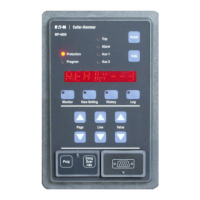
